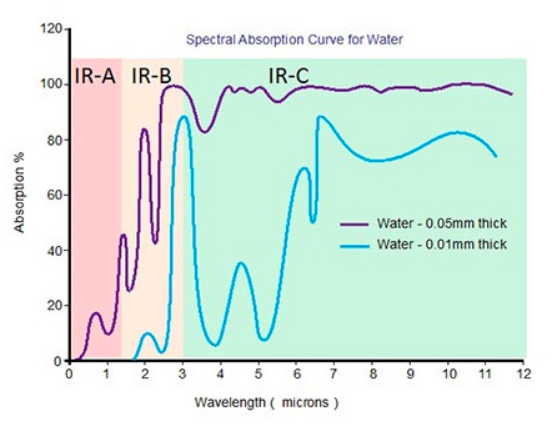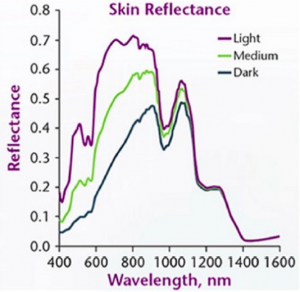
Infrared Wave Analysis


“Infrared Heating” is commonly understood to be Shortwave or Middlewave Infrared, here we have a basic infrared wave analysis. Tungsten Halogen or Quartz lamps that emit red light are popular in outdoor heating and large public spaces. Construction industry professionals and others are aware there are different categories of infrared, but unaware that the differences are important when matching a heater type to the correct function.
Our Heat My Space infrared wave analysis compares short and medium waves with far infrared, to demonstrate why far infrared creates what is known as ‘Comfort Heating’ – that is – the comfortable heating of people or animals where skin contact is desirable.
The infrared wave analysis will explain why far infrared is the future for heating specific internal environments. For example; homes, offices and restaurants. However, exclude large space areas such as; factories, garages, warehouses, workshops where short & medium wave is more effective.
Far Infrared is biologically more significant in comfort heating than shorter (hotter) heat wavelengths because the skin has an 80% water content. Water absorbs heat wavelengths from 3 microns and above (Far Infrared). Far Infrared is better absorbed by the skin than other wavelengths; it is less “transmissive” and is not reflected – this is not so for shorter wavelengths.
Hotter heaters do not mean more comfortable, but it does mean the use of more energy. Quartz heaters may be “hotter” at 3 microns than Far Infrared heaters, but the intensity of the heat is more suitable to industrial drying applications, sending heat long distances, and combating the effects of the outdoors – therefore not Comfort Heating. Far infrared creates Comfort Heating whilst consuming less energy.
Natures in-built defence mechanism against high temperatures allows the skin to reflect a large percentage of shortwave energy and prevents its effective absorption. However Shortwave is still very transmissive (i.e. it penetrates deep into the skin). Academic research (citations below) recommends skin and eye protection from very hot short wavelengths. Shortwave is therefore not suitable for Comfort Heating.

Infrared – A is classified as the ‘hottest’ infrared with temperatures up to 2,700C and wavelengths of 0.7 – 1.4 microns and is also called “Short-wave” or “Near” Infrared.
Infrared – B is infrared with temperatures of 500 – 800C and wavelengths of 1.4 – 3 microns and are also called ‘Middlewave’ or ‘Medium’ Infrared.
Infrared – C is infrared with temperatures of less than 500C and is the final and broadest waveband of 3 microns – 1mm and is also called ‘Longwave’ or Far Infrared.
The graph shows the spectral output of lamps emitting within each of these 3 wavelengths. All the lamps have an output of different wavelengths and in different intensities.
All of the lamps output in the Far Infrared wavelengths but not all of the output in the shorter wavelengths;
The shorter the emitter wavelength, the larger proportion of energy is emitted in those shorter wavelengths (i.e. they peak earlier).
These wavelength groupings are important to understand as they cover very different temperatures. They range from light-emitting (appears as a red glow) to non-light emitting (no glare or dark). The wavelengths have very specific properties in terms of heat absorption, transmission and reflection by the materials they touch.
Reflection: When infrared is reflected it does not convert into heat for the target material (skin, fabrics, objects).
Transmission: When infrared is converted to heat in the transmitting region, this depends on the thickness of the target and how much infrared transmits. Transmission is not absorption, it is heat passing through and this is very important to understand – especially for Comfort Heating. High transmission implies low absorption and vice versa (high absorption = low transmission).
Absorption: When infrared is absorbed it is converted into lasting heat in the target object. High absorption with low transmission properties means the direct radiant heat itself may not penetrate very deeply into the target material, but it can be transmitted onwards by conduction within the material (by the blood and other tissues in the case of skin). As the skin is 80% water, for Comfort heating and gentle drying purposes, we want an emitter lamp/ heater optimised to output in the wavelengths best absorbed by water (Robinson, 2014), which reflects the least, and for which transmission is possible by conduction or other means.

The graph shows, of the three infrared bands, water begins to absorb effectively at 3 microns (regardless of depth) and then again at 6 microns (for thin layers). Importantly this for the most part the Far Infrared region.
Skin absorbs heat principally because of its 80% water content (Robinson 2014), making Medium/Far and Far Infrared the most biologically significant band for heat absorption and this translates to “more effective heating” by heaters peaking in these bands.
Heaters emitting IR-A , Short wave, will still heat and still emit Far infrared, but at lower densities than heaters optimised for Far Infrared output and consequently will be less efficient, whilst consuming more energy.

The skin has evolved to accommodate infrared in many ways to maximise (or reject) its various properties and the skin’s reaction depends on wavelength. The graph demonstrates the biologically significant reflection of Infrared-A/Short Wave by the skin. Reflection of the infrared heat is high in the short wavelengths and then decreases after 1.4 microns.
Snow, leaves of plants and black paint also reflect shortwaves similarly.
The graph illustrates that a large proportion of IR-A (Shortwave) will be reflected and not cause heating. This is a defence mechanism of the skin, to protect it from damaging ‘hot’ shortwave energy waves.
The infrared waves in longer wavelengths assist considerably with absorption and low reflection – two essential properties of heating material. Conversely, Infrared-A is neither absorbed well and is highly reflected.

This graph demonstrates that transmission into the skin is a function of wavelength. Infrared A/Short wave due to its lower absorption is the most highly transmissive into the skin.
Schroeder et al indicate up to 65% of Near IR are capable of reaching through the epidermis and up to 2 microns deep into the dermis. Beyond 2 microns the skin is impenetrable to all types of Infrared. Transmission must not be confused with absorption in terms of heat effectiveness. Because of the very high temperatures of shortwave infrared, the high transmission rate can cause damage through greater penetration of the skin and a lower rate of absorption.
No infrared is capable of reaching the muscle layers. In the subcutaneous tissue heat transfer is via conduction or diffusion, convection of heated fluids, blood etc, not by direct radiant heating and therefore more naturally favours processes that encourage absorption.
Infrared B and C (medium & far infrared) are the only infrared waves that transmit into the skin’s surface micro-region and are more highly absorbed into water and the blood than Infrared A making more effective onward conduction into the body fluids and conduction through the tissue and blood.
As Infrared A is more transmissive in both the skin and eyes it overcomes the natural high reflectivity of the skin which is a defence mechanism. Installers and Operators of shortwave infrared must bear in mind the high temperatures of Infrared A and consider the exposure time and distance from the heater. Schroeder and others indicate Infrared A as being as harmful as UV light in terms of its ageing effects (Schroeder P, Calles C, Krutmann J. Prevention of infrared-A radiation mediated detrimental effects in human skin. Skin Therapy Letters. 2009 Jun; 14(5):4-5.)
Prolonged IR-A exposure can cause eye damage. Goggles and time limits are recommended by Dr Janet Voke in Radiation effects on the eye, Part 1 – Infrared radiation effects on ocular tissue, Optometry Today, May 1999.
Far Infrared emits the most biologically significant Comfort Heating wavelengths because skin content is 80% water which only absorbs heat wavelengths from 3 microns and lower (Far Infrared). Far Infrared is, therefore, better absorbed by the skin, less transmissive and less reflected. Academic research (citations below) recommends skin and eye protection from very hot short wavelengths.
“Preferred wavelengths for Comfort Heating“. Dr Gerard McGranaghan.
Peter Schroeder, Judith Haendeler, Jean Krutmann, The role of near-infrared radiation in photo ageing of the skin, Experimental Gerontology, Volume 43, Issue 7, July 2008, Pages 629-632, ISSN 0531- 5565,
Soyun Cho, Mi Hee Shin, Yeon Kyung Kim, Jo-Eun Seo, Young-Mee Lee, Chi-Hyun Park and Jin Ho Chung, Effects of Infrared Radiation and Heat on Human Skin Ageing in vivo, Journal of Investigative Dermatology Symposium Proceedings (2009) 14, 15–19;
Schroeder P, Calles C, Krutmann J. Prevention of infrared-A radiation mediated detrimental effects in human skin. Skin Therapy Letters. 2009 Jun; 14(5):4-5.
Dr Janet Voke, Radiation effects on the eye, Part 1 – Infrared radiation effects on ocular tissue, Optometry Today, May 1999.

